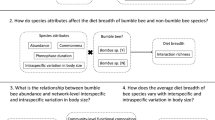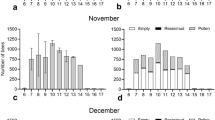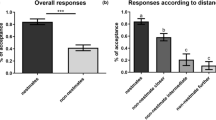Abstract
The host examination behavior of the parasitoid wasp Trichogramma minutumon spherical Manduca sextahosts is described. The mean walking speed during host examination was 0.64 ± 0.03 mm s −1 and is independent of wasp size. The paths taken by the wasps are not evenly distributed over the host surface; the majority of time is spent below 45 ° latitude. The distribution of oviposition sites is also nonrandom with respect to latitude and is not influenced by phototaxic and geotaxic responses. The initial transit made by the wasps over the host surface is a straight path which frequently passes across the highest point on the host. The length and duration of the initial transit are independent of wasp body length. However, stride length and stepping rates are proportional to wasp body length, and small wasps take more steps to complete their initial transit. The roles of the examination walk in host recognition and host volume measurement by Trichogrammaare also discussed.
Similar content being viewed by others
References
Ables, J. R., Vinson, S. B., and Ellis, J. S. (1981). Host description byChelonus insularis (Hym: Braconidae),Telenomus heliothidis (Hym: Scelionidae), andTrichogramma pretiosum (Hym: Trichogrammatidae).Entomophaga 26: 149–156.
Beevers, M., Lewis, W. J., Gross, H. R., and Nordlund, D. A. (1981). Kairomones and their use for management of entomophagous insects. X. Laboratory studies on manipulations of host-finding behavior ofTrichogramma pretiosum Riley with a kairomone extracted fromHeliothis zea (Boddie) moth scales.J. Chem. Ecol. 7: 635–648.
Clausen, C. P. (1940).Entomophagous Insects, McGraw-Hill, New York.
Clausen, C. P., Gardner, T. H., and Sato, K. (1932). Biology of some Japanese and Chinese grub parasites.U.S. Dept. Agr. Tech. Bull. 308.
De Jong, E. J., and Pak, G. A. (1984). Factors determining differential host-egg recognition of two host species by differentTrichogramma spp.Meded. Fac. Landbouww. Rijksuniv. Gent 49: 815–825.
Delcomyn, F. (1971). The locomotion of the cockroachPeriplaneta americana.J. Exp. Biol. 54: 443–452.
Delcomyn, F. (1985). Walking and running. In Kerkut, G. A., and Gilbert, L. I. (eds.).Comprehensive Insect Physiology, Biochemistry and Pharmacology, Vol. 5, Pergamon Press: Oxford, pp. 439–466.
Edwards, R. L. (1954). The host-finding and oviposition behaviour ofMormoniella vitripennis (Walker), a parasite of muscoid flies.Behaviour 7: 88–112.
Epstein, S., and Graham, D. (1983). Behaviour and motor output for an insect walking on a slippery surface. I. Forward walking.J. Exp. Biol. 105: 215–229.
Flanders, S. E. (1935). Host influence on the prolificacy and size ofTrichogramma.Pan-Pacif. Entomol. 11: 175–177.
Graham, D. (1985). Pattern and control of walking in insects.Adv. Insect Physiol. 18: 31–140.
Jackson, D. J. (1966). Observations on the biology ofCaraphractuc cinctus Walker (Hymenoptera:Mymaridae), a parasitoid of the eggs of Dytiscidae (Coleoptera). III. The adult life and sex ratio.Trans. R. Entomol. Soc. Lond. 118: 23–49.
Jones, R. L., Lewis, W. J., Beroza, M., Bierl, B. A., and Sparks, A. N. (1973). Host-seeking stimulants (kairomones) for the egg-parasiteTrichogramma evanescens.Environ. Entomol. 2: 593–596.
Keller, M. A. (1987). Influence of leaf surfaces on movements by the hymenopterous parasitoidTrichogramma exiguum.Entomol. Exp. Appl. 43: 55–59.
Klomp, H., and Teerink, B. J. (1962). Host selection and number of eggs per oviposition in the egg parasiteTrichogramma embryophagum Htg.Nature Lond. 195: 1020–1021.
Klomp, H., and Teerink, B. J. (1967). The significance of oviposition rates in the egg parasite,Trichogramma embryophagum Htg.Arch. Neerl. Zool. 17: 350–375.
Klomp, H., Teerink, B. J., and Ma, W.-C. (1980). Discrimination between parasitized and unparasitized hosts in the egg parasiteTrichogramma embryophagum (Hym., Trichogrammatidae): a matter of learning and forgetting.Neth. J. Zool. 30: 254–277.
Laing, J. (1938). Host-finding by insect parasites. II. The chance ofTrichogramma evanescens finding its hosts.J. Exp. Biol. 15: 281–302.
Lewis, W. J., Jones, R. L., and Sparks, A. N. (1972). A host-seeking stimulant for the egg parasiteTrichogramma evanescens: Its source and a demonstration of its laboratory and field activity.Ann. Entomol. Soc. Am. 65: 1087–1089.
Lewis, W. J., Jones, R. L., Nordlund, D. A., and Gross, H. R., Jr. (1975). Kairomones and their use for management of entomophagous insects. II. Mechanisms causing increase in rate of parasitization byTrichogramma spp.J. Chem. Ecol. 1: 349–360.
MacMillan, D. L., and Kien, J. (1983). Intra- and intersegmental pathways active during walking in the locust.Proc. R. Soc. Lond. B 218: 287–308.
Marston, N., and Ertle, L. R. (1969). Host age and parasitism byTrichogramma minutum (Hymenoptera: Trichogrammatidae).Ann. Entomol. Soc. Am. 62: 1476–1482.
Noldus, L. P. J. J., and van Lenteren, J. C. (1985). Kairomones for the egg parasiteTrichogramma evanescens Westwood. II. Effect of contact chemicals produced by two of its hosts,Pieris brassicae L. andPieris rapae L.J. Chem. Ecol. 11: 793–800.
Price, P. W. (1970). Biology and host exploitation byPleophus indistinctus.Ann. Entomol. Soc. Am. 63: 1502–1509.
Quednau, W. (1960). Uber die Identität derTrichogramma-Arten und einiger ihrer Okotypen (Hymenoptera, Chalcidoidea, Trichogrammatidae).Mitt. Biol. Bund. Ld-u Forstw. 100: 11–50.
Salt, G. (1934). Experimental studies in insect parasitism. I. Introduction and technique. II. Superparasitism.Proc. R. Soc. Lond. B 15: 81–95.
Salt, G. (1935). Experimental studies in insect parasitism. III. Host selection.Proc. R. Soc. Lond. B 117: 413–435.
Salt, G. (1937). The sense used byTrichogramma to distinguish between parasitized and unparasitized hosts.Proc. R. Soc. Lond. B 122: 57–75.
Salt, G. (1958). Parasite behaviour and the control of insect pests.Endeavour July: 145–148.
Schmidt, J. M., and Smith, J. J. B. (1985a). Host volume measurement by the parasitoid waspTrichogramma minutum: The roles of curvature and surface area.Entomol. Exp. Appl. 39: 213–221.
Schmidt, J. M., and Smith, J. J. B. (1985b). The mechanism by which the parasitoid waspTrichogramma minutum responds to host clusters.Entomol. Exp. Appl. 39: 287–294.
Schmidt, J. M., and Smith, J. J. B. (1986). Correlations between body angles and substrate curvature in the parasitoid waspTrichogramma minutum: A possible mechanism of host radius measurement.J. Exp. Biol. 125: 271–285.
Schmidt, J. M., and Smith, J. J. B. (1987a). Measurement of host curvature by the parasitoid waspTrichogramma minutum, and its effect on host examination and progeny allocation.J. Exp. Biol. 129: 151–164.
Schmidt, J. M., and Smith, J. J. B. (1987b). The effect of host spacing on the clutch size and parasitization rate ofTrichogramma minutum Riley.Entomol. Exp. Appl. 43: 125–132.
Schmidt, J. M., and Smith, J. J. B. (1987c). The measurement of exposed host volume by the parasitoid waspTrichogramma minutum and the effects of wasp size.Can. J. Zool. 65: 2837–2845.
Schmidt, J. M., and Smith, J. J. B. (1987d). The external sensory morphology of the legs and hairplate system of femaleTrichogramma minutum.Proc. R. Soc. Lond. B 232: 323–366.
Sengonca, C., and Klingauf, F. (1973). Verhalten eines Blattlaus-Parasiten und seiner Wirte in Abhängigkeit von ökologischen Faktoren.Zool. Jb. Syst. 100: 81–106.
Starzhinskii, V. M. (1982).An Advanced Course of Theoretical Mechanics, Mir, Moscow.
Strand, M. R., and Vinson, S. B. (1982). Source and characterization of an egg recognition kairomone ofTelenomus heliothidis, a parasite ofHeliothis virescens.Physiol. Entomol. 7: 83–90.
Strand, M. R., and Vinson, S. B. (1983). Factors affecting host recognition and acceptance in the egg parasitoidTelenomus heliothidis (Hymenoptera: Scelionidae).Environ. Entomol. 12: 1114–1119.
Suzuki, Y., Tsuji, H., and Sasakawa, M. (1984). Sex allocation and effects of superparasitism on secondary sex ratios in the gregarious parasitoid,Trichogramma chilonis (Hymenoptera: Trichogrammatidae).Anim. Behav. 32: 478–484.
van Alphen, J. J. M. (1980). Aspects of the foraging behaviour ofTetrastichus asparagi Crawford andTetrastichus spec, gregarious egg parasitoids of the Asparagus beetlesCrioceris asparagi L. andC. duodecumpunctata L. I. Host-species selection, host-stage selection and host discrimination.Neth. J. Zool. 30: 307–325.
van Dijken, M. J., and Waage, J. K. (1987). Self- and conspecific superparasitism by the egg parasitoidTrichogramma evanescens.Entomol. Exp. Appl. 43: 183–192.
van Lenteren, J. C., and DeBach, P. (1981). Host discrimination in three ectoparasites (Aphytis coheni, A. lingnanensis, andA. melinus) of the oleander scale (Aspidiotus nerii).Neth. J. Zool. 31: 504–532.
Viggiani, G. (1984). Bionomics of the aphelinidae.Annu. Rev. Entomol. 29: 257–276.
Vinson, S. B. (1976). Host selection by insect parasitoids.Annu. Rev. Entomol. 21: 109–133.
Vinson, S. B. (1985). The behaviour of parasitoids. In Kerkut, G. A., and Gilbert, L. I. (eds.).Comprehensive Insect Physiology, Biochemistry and Pharamacology, Vol. 9, Pergamon Press: Oxford, pp. 417–469.
Waage, J. K. (1978). Arrestment responses of a parasitoid,Nemeritis canescens, to a contact chemical produced by its host,Plodia interpunctella.Physiol. Entomol. 3: 135–146.
Waage, J. K. (1979). Foraging for patchily-distributed hosts by the parasitoid,Nemeritis canescens (Grav.).J. Anim. Ecol. 48: 353–371.
Waage, J. K., and Lane, J. A. (1984). The reproductive strategy of a parasitic wasp. II. Sex allocation and local mate competition inTrichogramma evanescens.J. Anim. Ecol. 53: 417–426.
Waage, J. K., and Ng, S. M. (1984). The reproductive strategy of a parasitic wasp. I. Optimal progeny and sex allocation inTrichogramma evanescens.J. Anim. Ecol. 53: 401–415.
Wajnberg, E. (1987). Analysis of variations of handling time inTrichogramma maidis (Hym.: Chalc). Abstracts: European Workshop on Parasitoid Insects, Lyon, September.
Weber, H. (1974).Grundriss der Insektenkunde, Gustav Fischer Verlag, Stuttgart.
Witsack, W. (1973). Zur Biologie und Ökologie in Zickadeneiern parasitierender Mymaridan der Gattung Anagrus (Chalcidoidea, Hymenoptera).Zool. Jb. Syst. 100: 223–299.
Wylie, H. G. (1970). Oviposition restraint ofNasonia vitripennis (Hymenoptera: Pteromalidae) on hosts parasitized by other Hymenopterous species.Can. Entomol. 102: 886–894.
Wylie, H. G. (1971). Oviposition restraint ofMuscidifurax zoraptor on parasitized housefly pupae.Can. Entomol. 103: 1537–1544.
Wylie, H. G. (1972). Oviposition restraint ofSpalangia cameroni (Hymenoptera: Pteromalidae) on parasitized housefly pupae.Can. Entomol. 104: 209–214.
Zill, S. N., Moran, D. T., and Varela, F. G. (1981). The exoskeleton and insect proprioception II. Reflex effects of tibial campaniform sensilla in the American cockroachPeriplaneta americana.J. Exp. Biol. 94: 43–55.
Author information
Authors and Affiliations
Rights and permissions
About this article
Cite this article
Schmidt, J.M., Smith, J.J.B. Host examination walk and oviposition site selection ofTrichogramma minutum: Studies on spherical hosts. J Insect Behav 2, 143–171 (1989). https://doi.org/10.1007/BF01053289
Accepted:
Issue Date:
DOI: https://doi.org/10.1007/BF01053289




